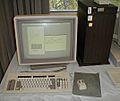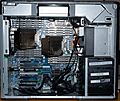Workstation facts for kids
A workstation is a very powerful computer used for special and complex tasks. These computers are usually expensive and have top-notch parts. They are much more powerful than the regular computers you might use for homework or browsing the internet. Workstations often use special operating systems that let many people work on the same computer at once. They are usually connected to a computer network, and sometimes people use special screens called Computer terminals to connect to them. Most workstations today use a Unix or similar operating system.
Workstation computers often have very strong CPUs, like the Intel Xeon or AMD Opteron, and some even have more than one CPU. They also have more memory (RAM) than a normal desktop computer. They often use very fast hard drives or solid-state drives (SSDs). Some workstations have special parts not usually found in regular computers, like ECC (error-corrected) memory, SCSI, fibre channel, and super-fast 10 gigabit Ethernet connections.
Some cool technologies that used to be only in workstations are now common in regular PCs. These include processors with many cores (multi-core), solid-state drives, graphics cards that speed up images, and better color displays. Also, faster internet, virtual memory, and the ability to run many programs at once without slowing down (pre-emptive multitasking) started with workstations.
Workstations are used for many important jobs. These include computer-aided design (CAD), which helps engineers design things. They are also used for creating amazing 3D graphics and animations, making movies and music, predicting the weather, and doing other simulations and scientific research.
Contents
Types of Processors in Workstations
Workstations have changed how they use CPUs over time. In the past, they often used a type of processor called RISC. Today, most modern workstations use a different type of processor called x86_64.
Older RISC Workstations
RISC processors were common in workstations a while ago. They included types like MIPS, PowerPC, or SPARC. Here are some examples of workstations that used RISC processors:
- Silicon Graphics IRIX machines (used MIPS CPUs)
- Sun Microsystems SparcStation (used SPARC CPUs)
- Apple Power Mac G5 and PowerBook G4 (used PowerPC CPUs)
- IBM IntelliStation POWER and ThinkPad Power Series (used PowerPC CPUs)
Modern x86_64 Workstations
Today, most workstations use x86_64 processors. These are the same type of processors found in many regular desktop computers, but the ones in workstations are much more powerful. Here are some examples of modern workstations:
- HP Z series
- Apple Mac Pro and MacBook Pro
- Dell Precision
Images for kids
-
Sun SPARCstation 10 with CRT monitor, from the early 1990s
-
Early Xerox workstation
-
HP 9000 model 735 running HP-UX and the Common Desktop Environment (CDE)
See also
 In Spanish: Estación de trabajo para niños
In Spanish: Estación de trabajo para niños










